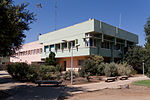Avivim school bus bombing
1970 mass shootings in Asia1970 murders in IsraelAttacks on buses by Palestinian militant groupsChild murder in IsraelExplosions in 1970 ... and 9 more
Mass shootings in IsraelMassacres in 1970Massacres in IsraelMassacres in Israel during the Israeli–Palestinian conflictMay 1970 events in AsiaSchool killings in IsraelSchool massacres in AsiaTerrorist incidents in Asia in 1970Terrorist incidents in Israel in the 1970s

The Avivim school bus bombing was a terrorist attack on an Israeli school bus on 22 May 1970, in which 12 civilians were killed, nine of them children, and 25 were wounded, one of whom died of a wound sustained in the attack 44 years later. The attack took place on the road to Moshav Avivim, near Israel's border with Lebanon. Two rocket-propelled grenades (RPGs) were fired at the bus. The attack was one of the first carried out by the PFLP-GC.
Excerpt from the Wikipedia article Avivim school bus bombing (License: CC BY-SA 3.0, Authors, Images).Avivim school bus bombing
8967, Galil Elyon Regional Council
Geographical coordinates (GPS) Address Nearby Places Show on map
Geographical coordinates (GPS)
| Latitude | Longitude |
|---|---|
| N 33.061944444444 ° | E 35.423333333333 ° |
Address
8967
Galil Elyon Regional Council
North District, Israel
Open on Google Maps









